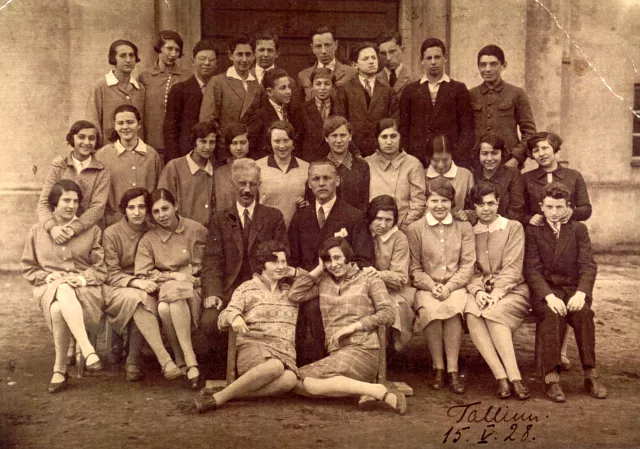Polina Rapoport with her schoolmates and teachers
These are teachers and students of the Tallinn Jewish lyceum, the class of my sister Polina Shein (nee Rapoport). The picture was taken in Tallinn in 1928.
2nd row, from left to right: Valentina Polyak, married Klompus, born in 1918, shot by Germans in September 1941 in Tallinn. Next to her is Anna, whose last name I don?t remember. The 4th to the left is the headmaster of the school, Samuel Gurin, next to him is mathematics teacher Motle Zhitomirskiy. To his right is Sarah Rybka and my sister Polina (2nd to the right in the 3rd row). 1st to the left in the 3rd row is nee Tsitron, I don?t remember her first name. 1st to the right is Sarah Borus. She survived the Holocaust and lived in Tallinn. 3rd to the right in the 4th row is Zalman Lerman. He survived the Holocaust and lived in Moscow after the war. I cannot remember or do not recognize the rest.
My elder sister Polina was born in 1912. Then my brother Samuel was born in 1917. I was the youngest, born in 1924. I was named Simon at birth. My father died in 1930 and mother being on her own took over father's business. She was constantly being busy and could not pay me enough attention. We were pretty well-heeled owing to our mother.
The three of us went to the Jewish lyceum. The building of that lyceum is still there. At present the premises of the Estonian Jewish community are there. When the lyceum was founded, most of the children knew neither Ivrit, nor Yiddish, so the subjects were taught in Russian and Ivrit was one of the subjects. Gradually more subjects were taught in Yiddish. My elder sister Polina studied in that lyceum in the period when subjects were taught in Russian. When my brother Samuel was studying there, subjects were taught in Russian only at the elementary school.
When I entered the Jewish lyceum, Ivrit was taught from the first grade. I always had a propensity to languages and soon I was pretty good in Ivrit. It was not hard for me to study. The lyceum was secular and Jewish religion and traditions were taught like one of the subjects. Teaching was in Ivrit with the exception of military class, taught by the captain of the Estonian army, and gymnastics, also taught in Estonian. He had his own system of physical training. He made us work out. I am grateful to him for that. First, my results were miserable and I had the poorest score. Then I started working and training hard and became a pretty good athlete. I enjoyed being able to stand out. I found going in for sports very challenging and spent a lot of time on that. I was master of sports in wrestling and took the first prize at a competition in Tallinn.






















